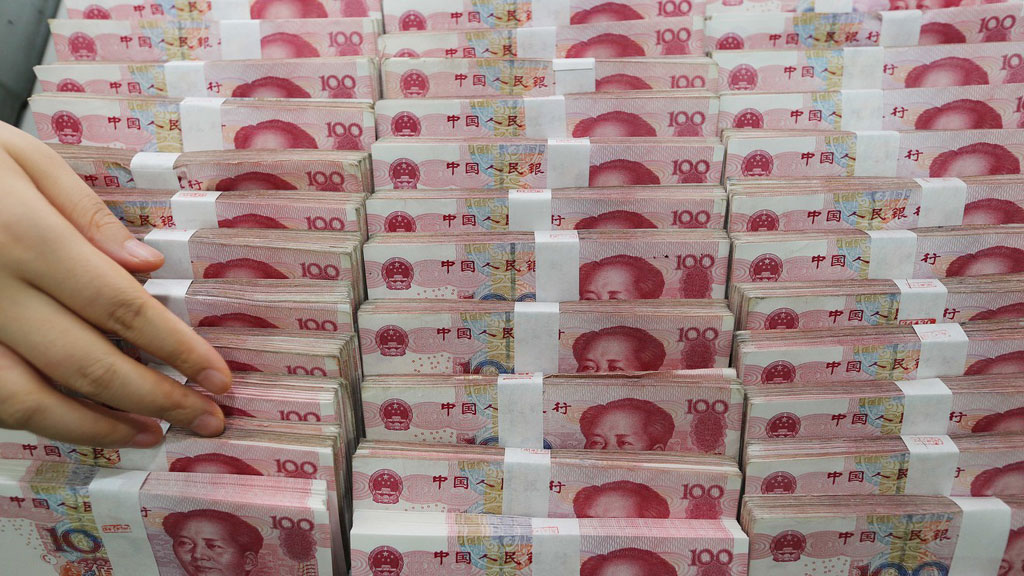Yuan set for longest monthly losing streak, more pressure ahead

SHANGHAI: China's yuan eased against the U.S. dollar on Wednesday and looked set to post its longest monthly losing streak on record as U.S. tariffs ratchet up pressure on the already slowing Chinese economy.
The yuan ended domestic onshore trade at 6.9734 per dollar at 0830 GMT, the weakest such close since May 20, 2008, and 59 pips or 0.08 percent weaker than the previous late night close.
If the yuan finishes the late night session around the same level, it will have lost 1.5 percent against the dollar in October, its seventh straight monthly loss and the longest such losing streak since the exchange rate was unified in 1994.
With no sign of a let-up in the Sino-U.S. trade war, investors are betting on more weakness ahead and expect authorities will eventually allow the yuan to breach the key 7 to the dollar level for the first time since the global financial crisis.
However, few expect a sudden devaluation or a sharp sell-off in the yuan like that seen in 2015-2016, which would spark capital outflows and more criticism from Washington of China's policies.
The Chinese currency has lost nearly 7 percent of its value to the dollar since the beginning of this year, and is down 10 percent since March, when the first set of tit-for-tat U.S. and Chinese tariffs were announced.
Prior to the market opening on Wednesday, the PBOC set its official yuan midpoint at a fresh 10-year low of 6.9646 per dollar, 72 pips or 0.1 percent weaker than the previous fix of 6.9574.
Wednesday's fixing, the weakest since May 20, 2008, came in largely matched market expectations. It was only 1 pip weaker than Reuters' estimate of 6.9645.
While the dollar rose to a 16-month high, the yuan was offered some respite after China's central bank announced details of a bill issuance in Hong Kong. Markets believe the move is an attempt to steady the yuan in offshore markets by soaking up yuan liquidity.
The People's Bank of China (PBOC) said that it will issue a total of 20 billion yuan ($2.87 billion) of bills out of Hong Kong next month, its first issuance in the former British colony, the world's biggest offshore yuan clearing centre. The sale had been announced previously but there were no details.
Analysts said the amount was small compared with total offshore yuan deposits but was a clear signal from authorities to the market that they were keen to defend the yuan from easily breaching the key 7 level.
"(It) indicates that the PBOC intends to increase the cost of funds in offshore market to squeeze the short yuan positions," Zhou Hao, senior emerging market economist at Commerzbank in Singapore said in a note.
Weaker-than-expected October factory data released earlier in the session did not affect spot yuan levels, but it did underscore expectations that Beijing will ease policy further to stabilise the economy, adding to pressure on the exchange rate in the longer-term, traders said.
China's manufacturing sector in October expanded at its weakest pace in over two years, hurt by slowing domestic and external demand.
So far this year, Chinese policymakers have been less interventionist on the yuan than they were in 2015, as a weaker currency helps cushion a slowing economy. But Sheng Songcheng, an advisor to the PBOC told media that China should use its foreign exchange reserves to stabilise the yuan's exchange rate when needed.
"We repeat our advice that the market should not read too much into the likelihood that USD/CNY will break above 7. It is likely to happen within the context of broad-based EM weakness," Win Thin, global head of currency strategy at Brown Brothers Harriman said in a note on late Tuesday.

















Comments
Comments are closed.